
The first Central Coast AirFest was held in 2018, and this was supposed to be the start of a yearly tradition. In 2019 the show was held again, but then the COVID-19 pandemic threw a spanner in the works. However after two years of absence the third edition was held in October 2022 in the Californian city of Santa Maria. Despite the sunny reputation of California, the positioning of Santa Maria on the coast caused the weather to be rather grey during the air show. But nonetheless the event turned out a great success.
Aircraft ranging from vintage warbirds to modern fighters were present both on the ground and in the air. Air show director Chris Kunkle was thrilled the show returned although the gap of two years meant “lots of figuring out all the stuff you forgot about”. But grinning he added: ”there is going to be a lot of noise!” And that was definitely the case! We present a pictorial review of the show.
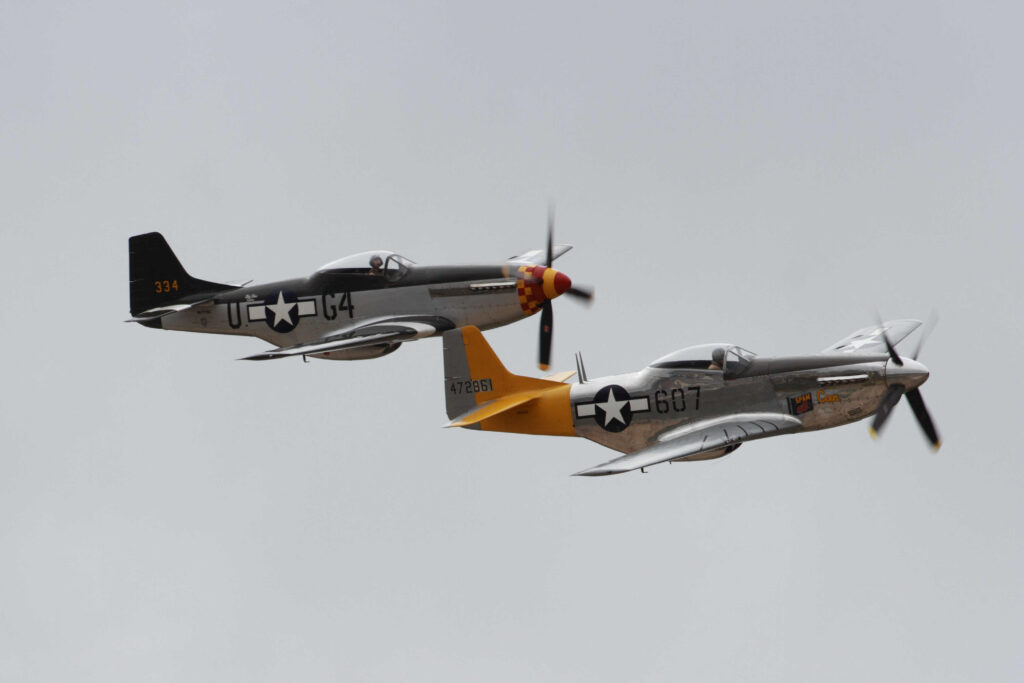
In total four North American P-51 Mustangs were present at Santa Maria, of which three did take to the air for some displays. Here two of them are flying together, ‘Spam Can’ in front and “Wee Willy II’ in the back. Both are operated by the Planes of Fame Air Museum at Chino and are often seen at air shows and such.
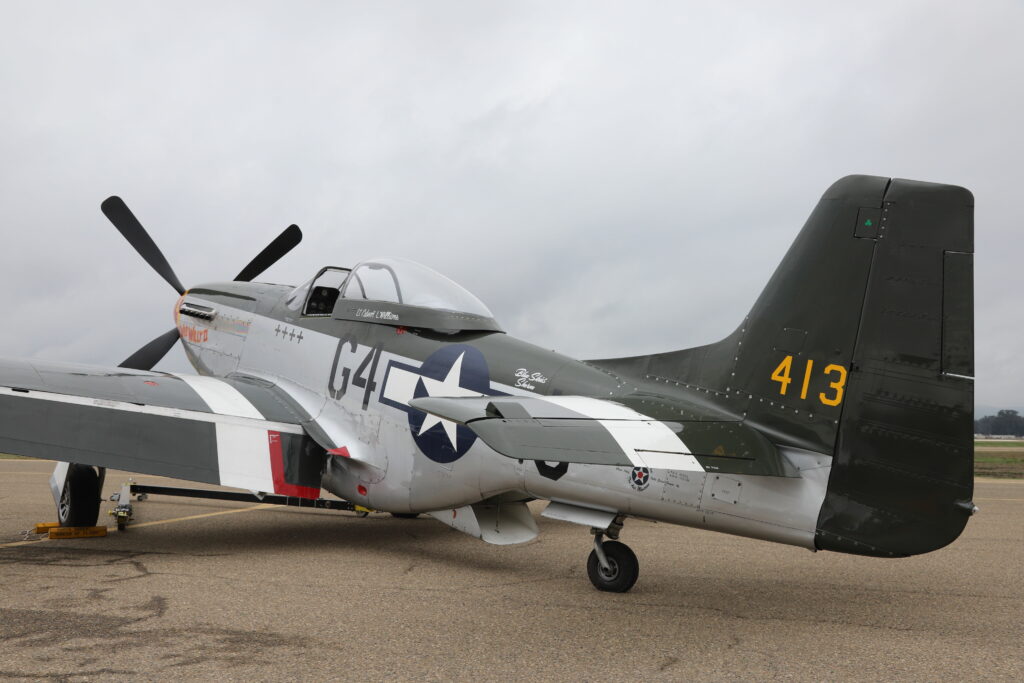
This P-51D Mustang served in the US Air Force until 1958 and was turned into a racer after being decommissioned. For this it was highly modified, and after some years it was even fitted with a Griffon engine with two contra-rotating propellers. With this power plant the Mustang managed to set the world piston speed record at 499 mph in August 1979 but it crashed only one month later during the famous Reno Air Races. However the famous warbird restorer Steve Hinton acquired the wreckage and managed to rebuild it to flying condition, again as a regular P-51. He still owns and flies it today as part of the Planes of Fame Air Museum.
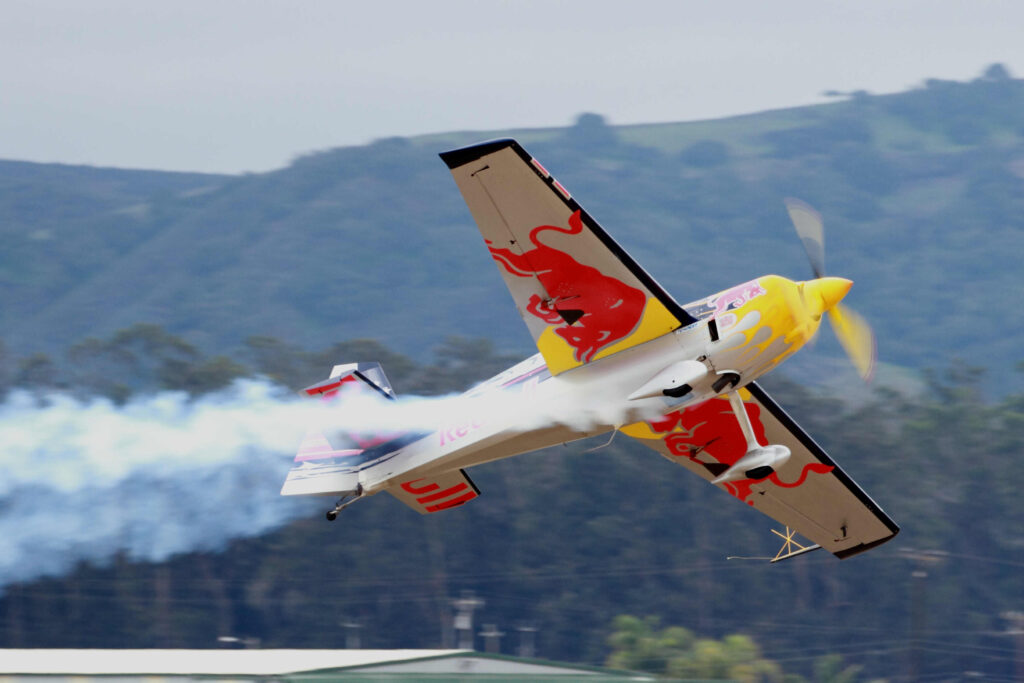
As could be expected from them, the “Red Bull Air Force” team gave some very spirited displays with amongst others a Bo.105 helicopter (even doing a loop) and this Zivko Edge 540. This dedicated aerobatic aircraft is seen here doing a knife edge pass, but really startled the crowd when it did something like a somersault in midair. Also other manoeuvres like flying straight into the vertical just hanging by the propeller and multiple corkscrews showed a great degree of skills and no doubt adrenaline, fitting for the sponsor.
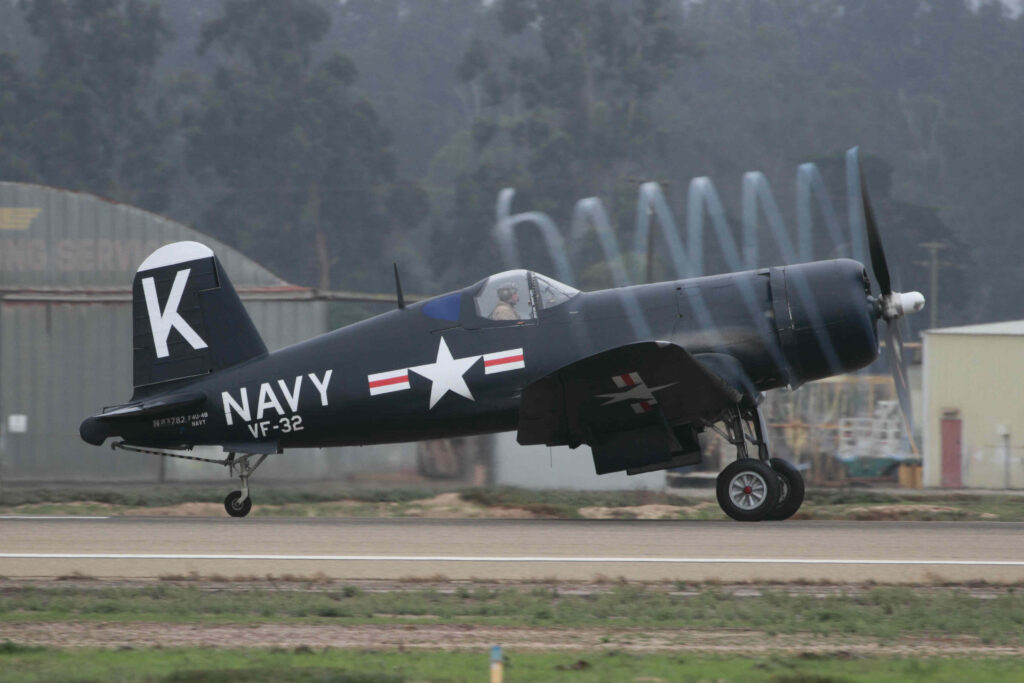
The F4U Corsair is probably the best known US Navy fighter aircraft of World War II, but the type also served during the Korean war. Almost 13.000 were built by designer Chance-Vought and also by Goodyear and Brewster. Chino based Planes of Fame Air Museum has one of the earlier ones in flying condition, that did serve in the Pacific in WWII. Due to the wet conditions during the air show it shows a nice vapour ‘cork screw’ when taking off for a spirited display.
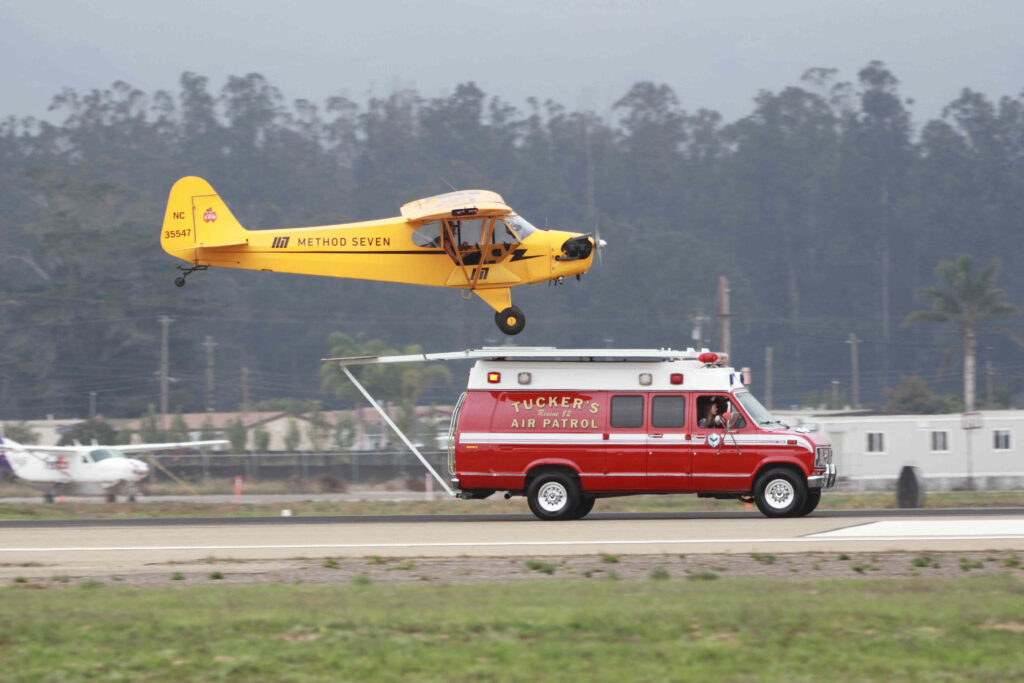
A really entertaining part of the show was the display by Eric Tucker. He plays the role of a tombola winner who has won a flight in a Piper J3 Cub but takes off on his own without the pilot. After a crazy flight during which the aircraft probably doesn’t fly straight for more than 10 yards he actually lands his 1941 aircraft on the roof of a driving van. And as there is no crane to lift if off the roof, he then takes off again from it!
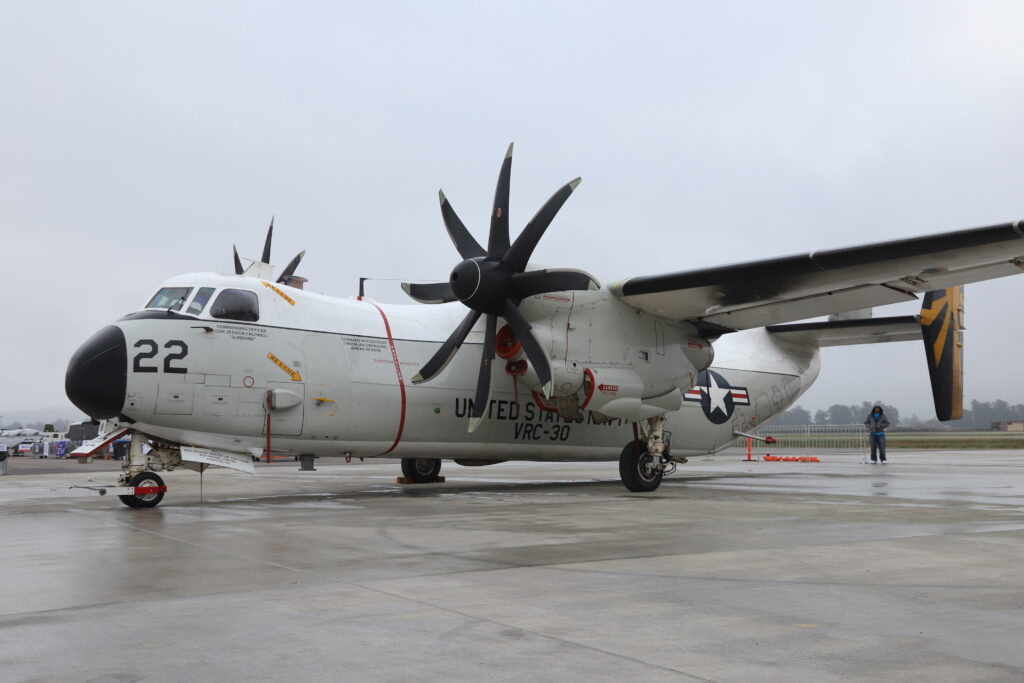
Not your everyday air show participant is this Grumman C-2A Greyhound of Fleet Logistics Support Squadron VRC-30 ‘Providers’, based at NAS North Island (CA). This plump looking aircraft is a so-called COD or carrier-onboard-delivery aircraft working for the US Navy. It provides logistical support by bringing cargo and passengers from and to a carrier while at sea. Because of its payload of up to 10,000 pounds and a large rear cargo door it can even transport a jet engine if needed and thanks to its folding wings it won’t take up too much space when parked on board of a carrier.
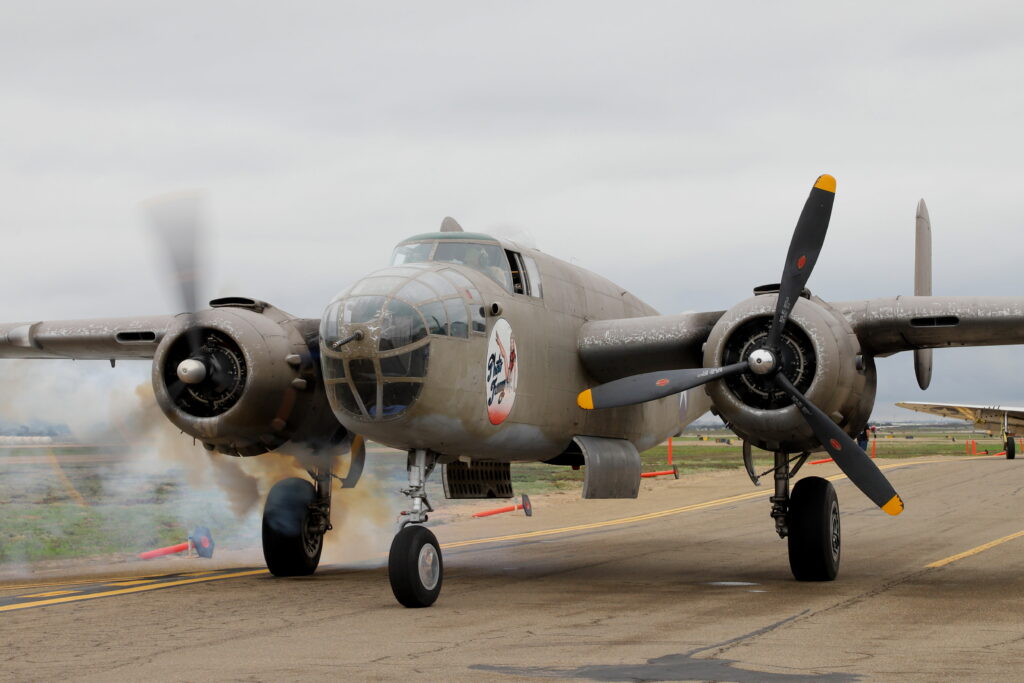
Starting up the engines of a World War II bomber is a smoky business, as is demonstrated here by B-25 ‘Photo Fanny’. The North American B-25 Mitchell bomber got famous when 16 of them did a bombing raid on Tokyo, flying from an aircraft carrier without fighter escort. Although the raid itself didn’t inflict too much damage on the Japanese, it was the first air raid against Japan after the Pearl Harbour attack and as such provided an important boost to American morale. Photo Fanny itself was produced in 1945 and didn’t see combat action. However it did have an interesting career both in the US Air Force (doing tests with an Electronic Research and Development Group) and after that in the civilian world amongst others as film star in multiple movies and also acting as camera ship.
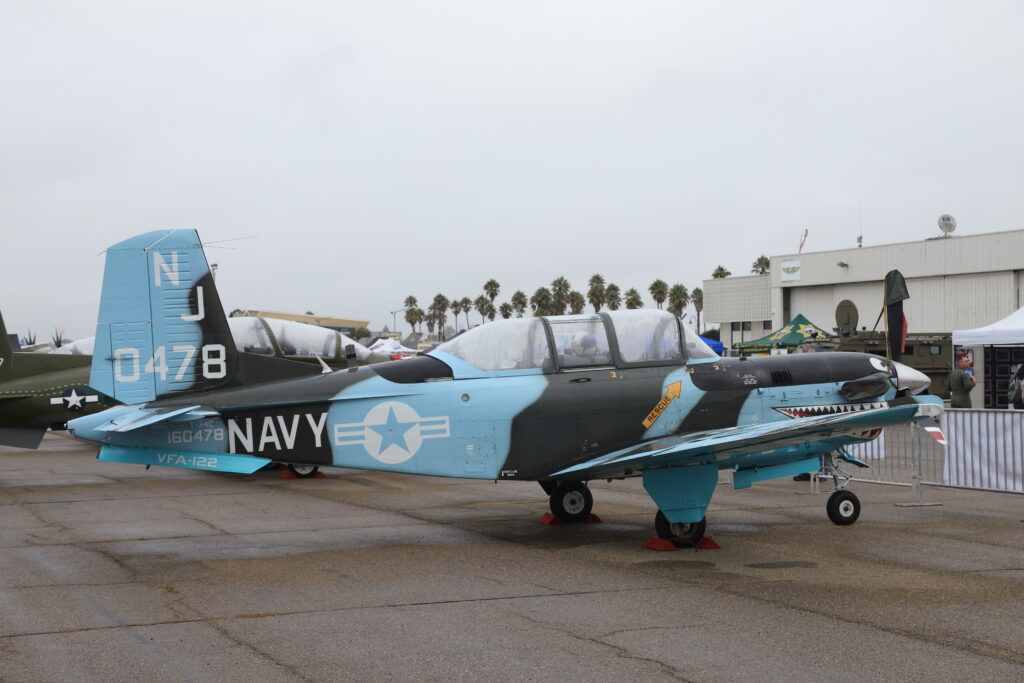
Not a warbird yet, but the oldest still operational military aircraft on show was this Beechcraft T-34C Turbo-Mentor, a training aircraft of the US Navy. Introduced in 1975 to replace the piston-engined T-34B Mentor, the US Navy bought no less than some 350 turbine-powered T-34C Turbo-Mentors. By now most T-34Cs have been withdrawn from use and fly with aero clubs and such, but the Navy still operates just over a dozen of them. The interesting camouflage pattern and shark mouth make this example even more attractive.
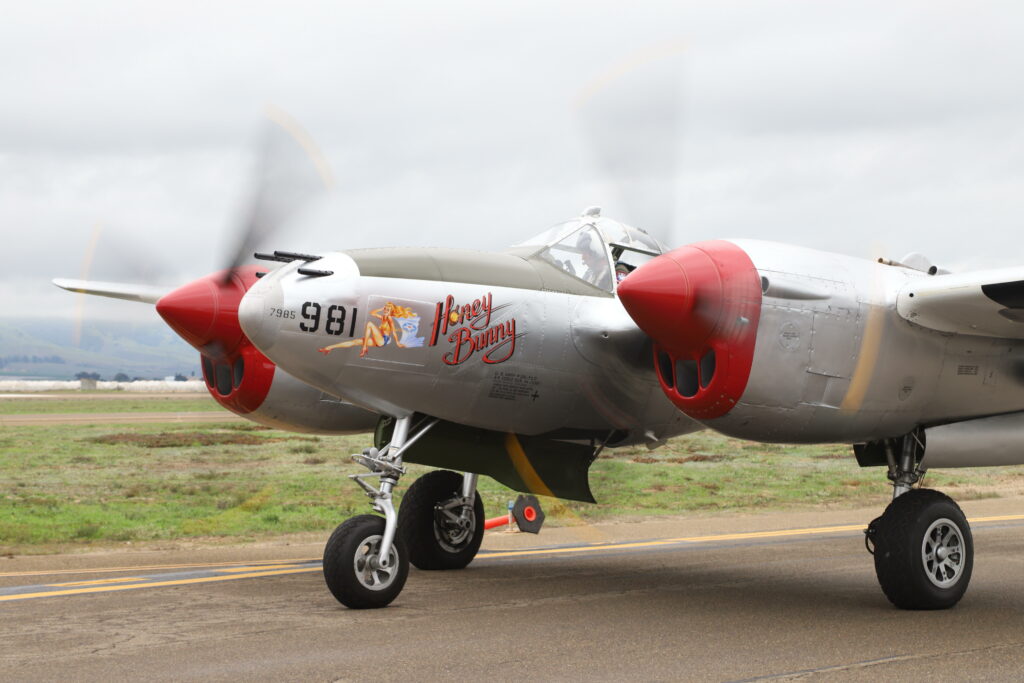
Nose art on military planes started appearing already before World War I, but during WW II it reached a height. Where the US Navy forbade it fully, the US Army Air Force tolerated the artwork for morale purposes. Both amateur and professional artists were chartered to paint the nose arts, which mostly consisted of mascots, names, and pin-up girls. ‘Honey Bunny’ is one of the two P-38 Lightnings present at Santa Maria. This is the only airworthy Lightning in the world in military colours that is in bare aluminium instead of camo, and the airframe allegedly is also the only one that has functional turbo-chargers.
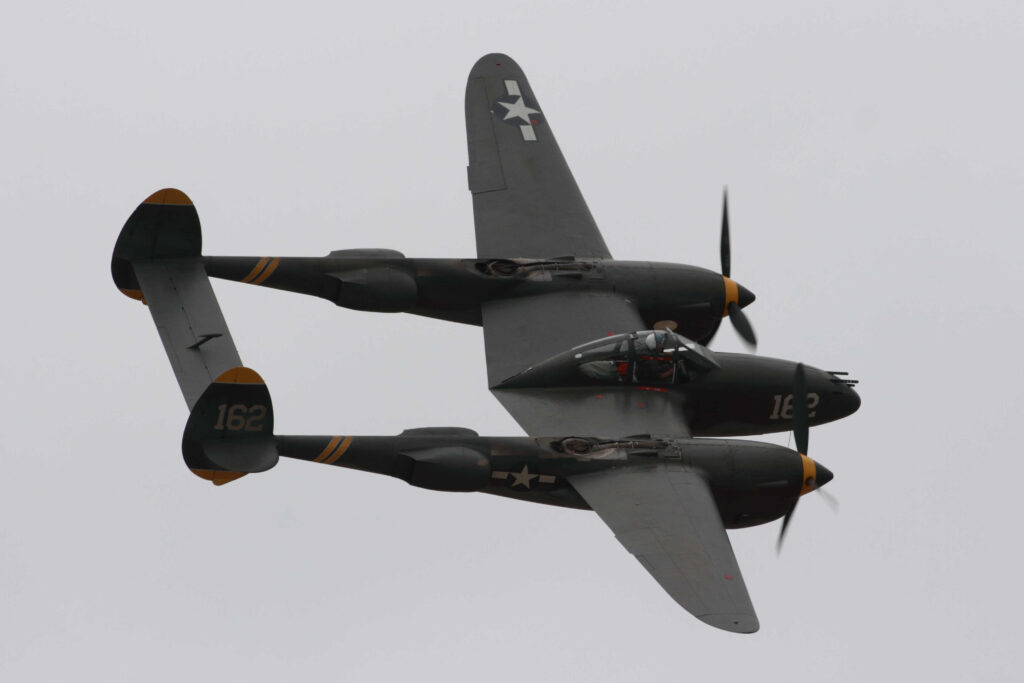
This P-38 Lightning is showing off its very peculiar shape during a flypast as the distinctive twin-boom design is clearly visible. Designed by Lockheed, this is one of the most famous American fighter aircraft of World War II. America’s two top aces, Dick Bong (40 aerial victories) and Tommy McGuire (38 victories) got most of their kills flying the P-38 in the Pacific. Although over 10.000 were built, nowadays worldwide there are just a handful left in flying condition. So having two of these at the show is a very rare occurrence.
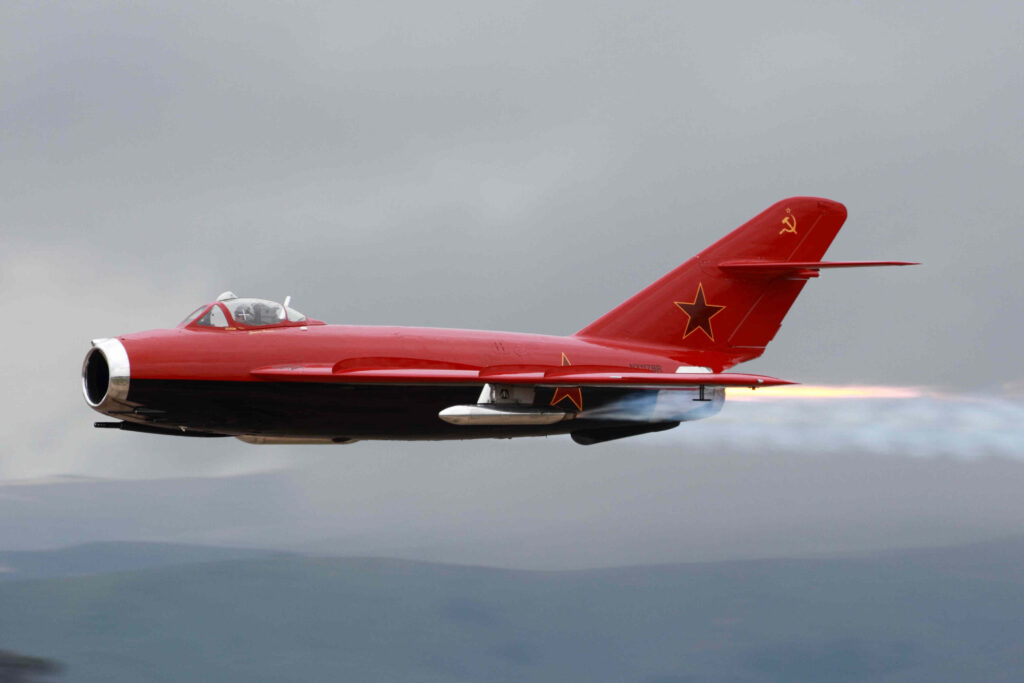
Not widely known is the fact that some versions of the Soviet built Mikoyan-Gurevich MiG-17 had an afterburner, but this MiG-17F shows it very clearly. The ‘Fresco’, as the NATO reporting name for this type is, is seen here doing a high speed pass with raw fuel being dumped in the exhaust, giving the aircraft a top speed of some 710 mph. Although painted with the well-known Soviet red star, this aircraft is actually a licence built Lim-5R that was operated by the Polish air force. Literally hundreds of these MiGs formed part of the backbone of the air forces of the Warsaw Pact during the Cold War, before they were replaced by more modern aircraft, but only after they proved to be very effective in amongst others Vietnam.
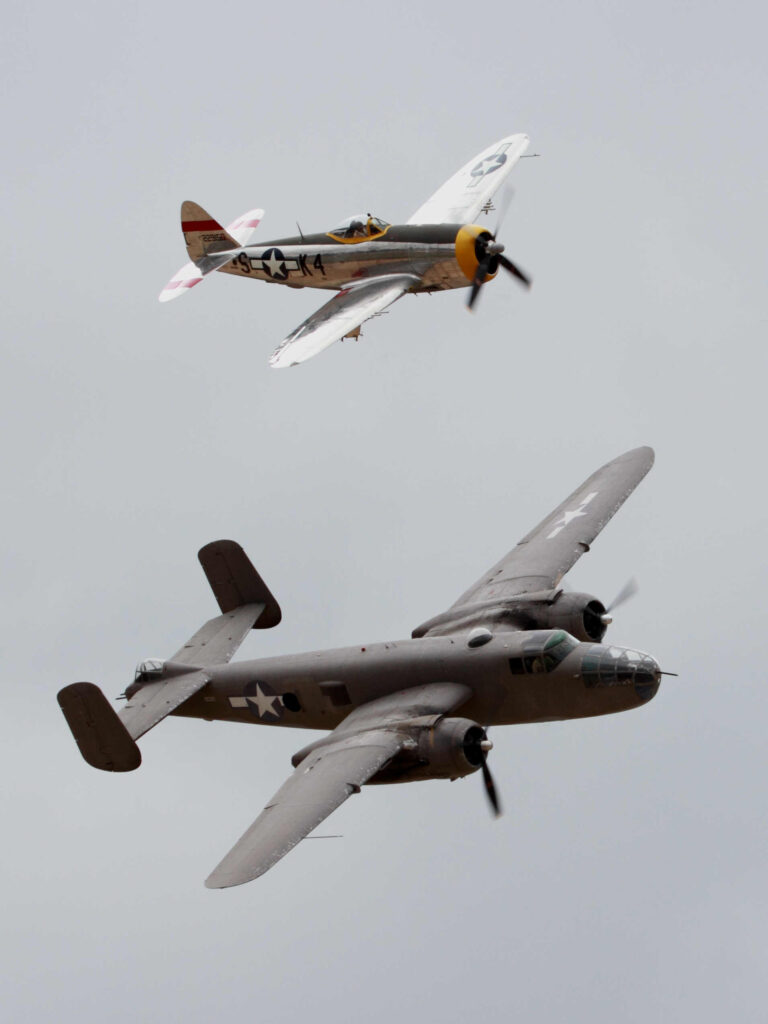
B-25 Mitchell ‘Photo Fanny’ is escorted by P-47 Thunderbolt ‘Dottie Mae’. Later on P-51 Mustangs took over, but during the first part of World War II bomber formations often had P-47s as fighter escort. Although their range was limited in the beginning, this later on improved, making the Thunderbolt a good escort aircraft. But when the Mustangs were introduced, the P-47 was put to use for air to ground missions. They were very good at this, as the Thunderbolt had excellent firepower and could also carry external weapons. And more importantly, with the big radial engine they could sustain damage from ground fires that would likely take down a Mustang.
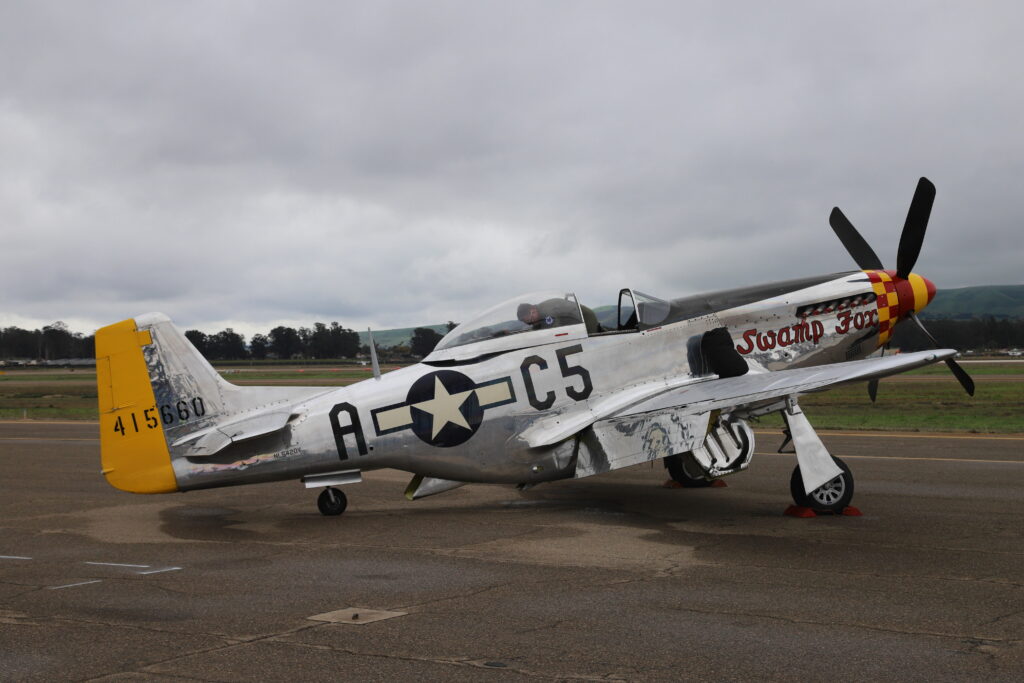
Although painted as P-51D 44-15660 ‘Swamp Fox’ of the 8th Air Force, as this fought from Leiston in the United Kingdom in 1944, this is actually P-51D 44-74202. Maybe the most interesting thing about this specific warbird is that it was actually based at Santa Maria Army Airfield directly after World War II for a short while. The aircraft was only retired from active duty in 1956. It was sold in 1957 and did fly in civilian hands for a while, but then spent decades on the ground before a thorough restoration was started in 2007. That took no less than five years, but in 2012 it made its first flight after restoration and hopefully it will keep on flying for a long time.
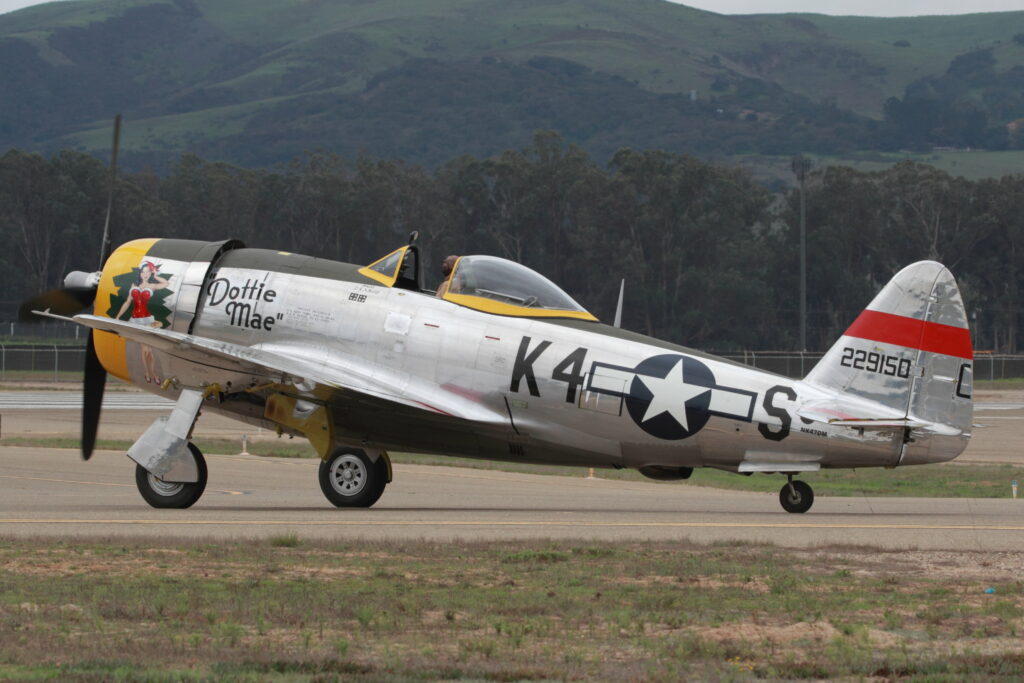
Republic P-47D ‘Dottie Mae’ had been lying belly up in an Austrian lake for sixty years after ditching in 1945 before she was recovered in 2005. After removing the dirt and calcium two original victory markings became visible beneath the cockpit with the outlines of a third one present as well. These were traced back to 16 April 1945 when a group of 405 FG P-47s was returning home after an attack on Magdeburg, Germany when they discovered an airfield beneath them. They were able to attack and destroy no less than 69 German aircraft (He111, Ju88, Fw190, Bf109 and even an Me262) and damaging another 48, three of which were accredited to Dottie Mae. The markings are still visible today. Only three weeks after this successful mission Dottie Mae was lost in the Traunsee in Austria, luckily pilot Lt Henry Mohr was able to escape the aircraft alive. During the restoration also some bullets and chunks of flak (anti-aircraft artillery) were found in the belly of the aircraft, testimony of its heavy wartime history.
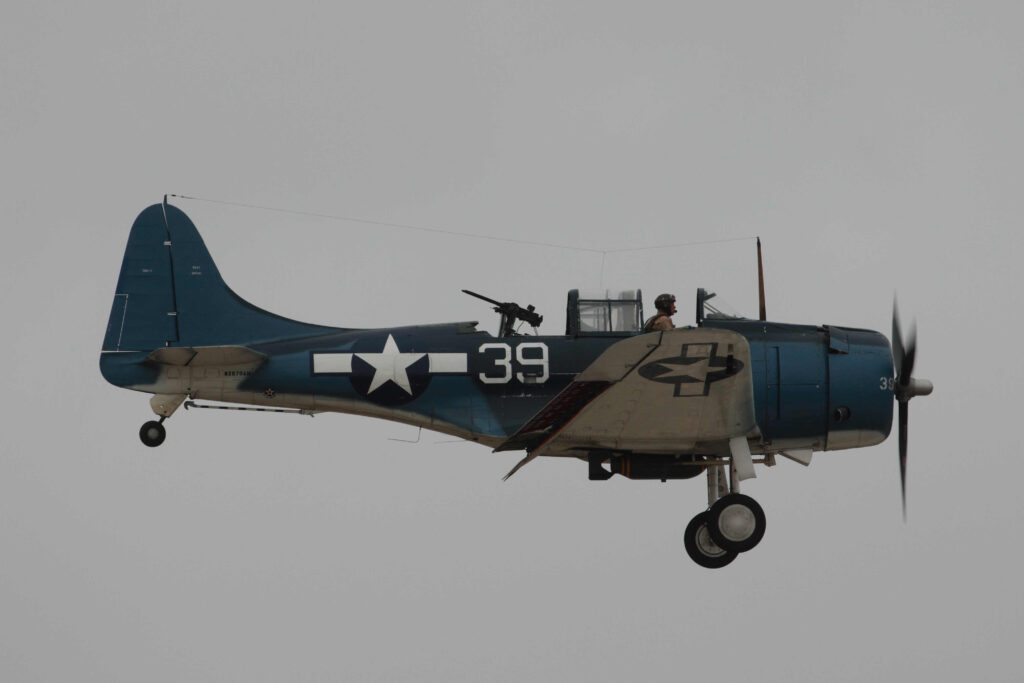
A very rare US Navy aircraft on show was this Douglas SBD-5 Dauntless, that somehow seems to fit in the murky weather. One can image it in the grey Pacific while fighting the Japanese. The type got famous there when a group of them managed to destroy all four present Japanese carriers during the Battle of Midway. Their main use was as dive bomber, but the aircraft were also used for reconnaissance. This particular example not only flew with the US Navy during World War II but also served a short spell with the New Zealand Air Force in that same war.
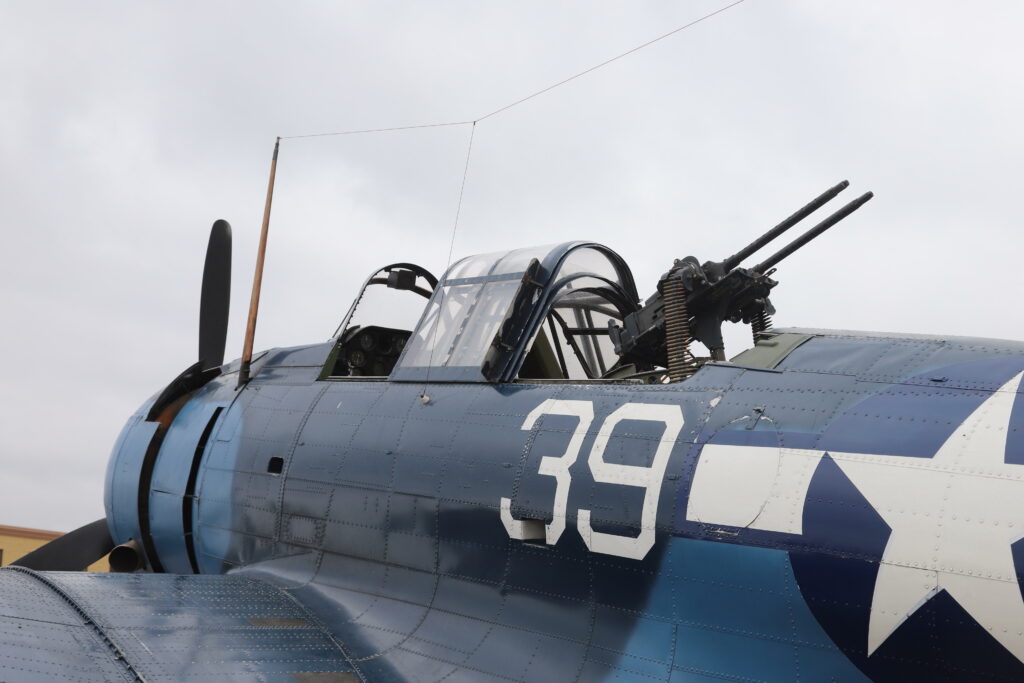
Next from the offensive 500 or 1.000 lbs bomb under the fuselage, the Dauntless had good defensive armament as well with two forward firing Browning .50 caliber machine guns and also these two .30 caliber machine guns on a rotating frame on the spine of the aircraft. These guns had been designed specifically for use on aircraft, with thinner barrels to keep the weight down. They could fire up to 1.500 rounds per minute and destroyed many Japanese fighters that thought they could easily attack the aircraft from behind.
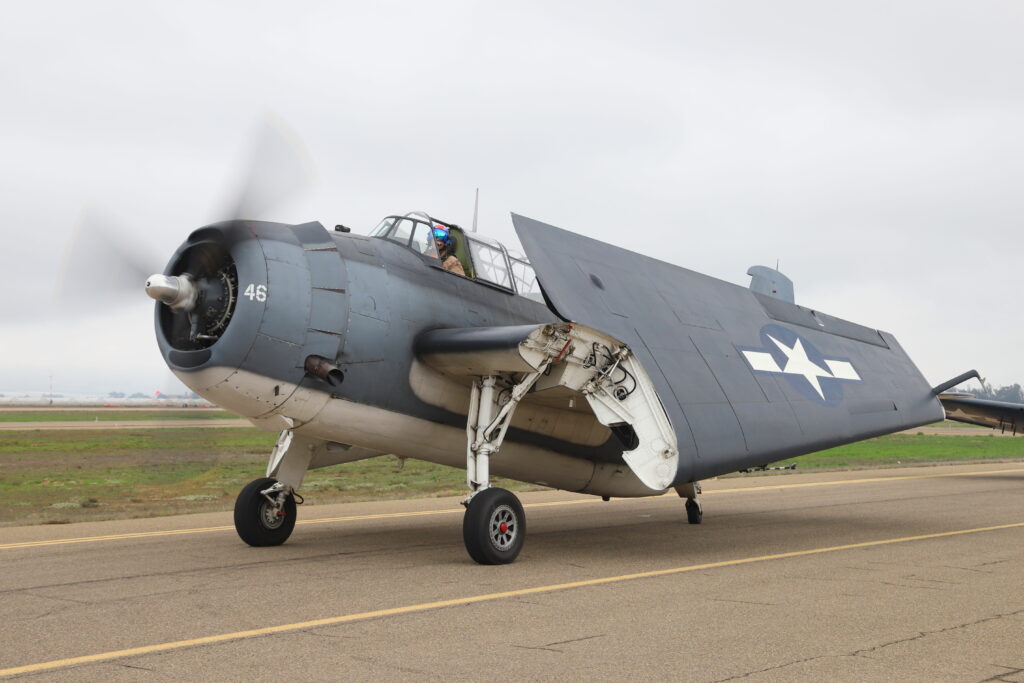
This Grumman TBM-3 Avenger is a torpedo bomber, designed for the US Navy and US Marine Corps during World War II. The type was heavily involved in the Pacific theatre of war, fighting the Japanese fleet, and is credited to sink over 30 submarines. It was the heaviest single-engined aircraft of World War II, and to be able to operate from carriers without taking too much space it was equipped with folding wings as can clearly be seen here.
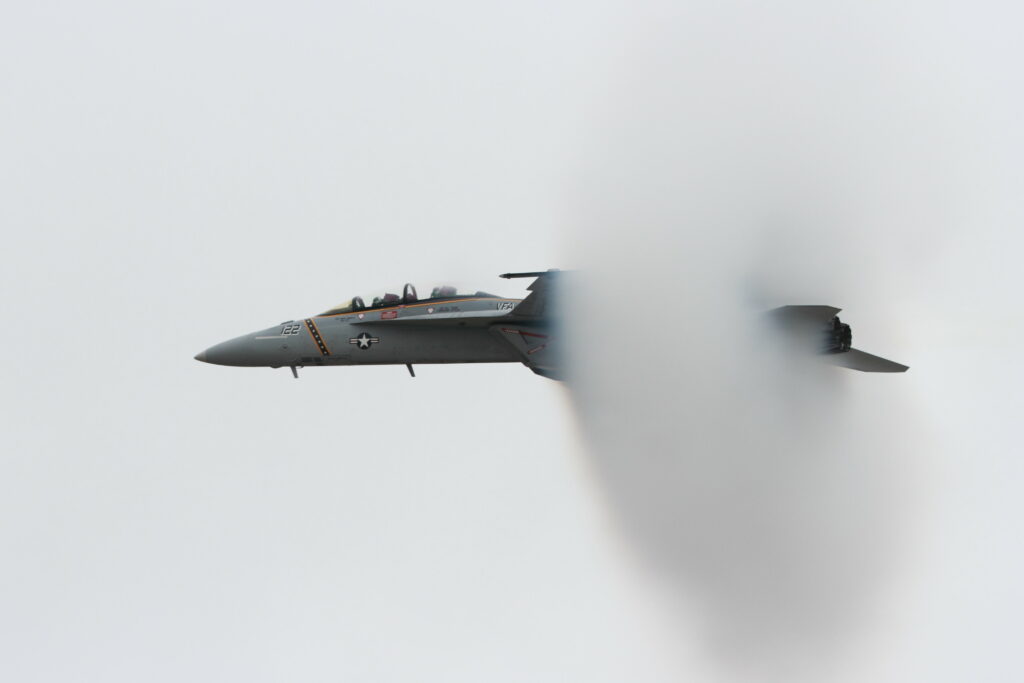
The 2022 West coast Rhino demo team were the first modern fighter to perform during the air show with their F/A-18F Super Hornet. The moisty air and the speed of the aircraft caused a so-called vapour cone or shock collar to form. This is caused by a drop of air temperature directly around the aircraft due to a drop in air pressure which itself is caused by the high speed near Mach 1 (the speed of sound). The result is this impressive cloud around the Hornet.
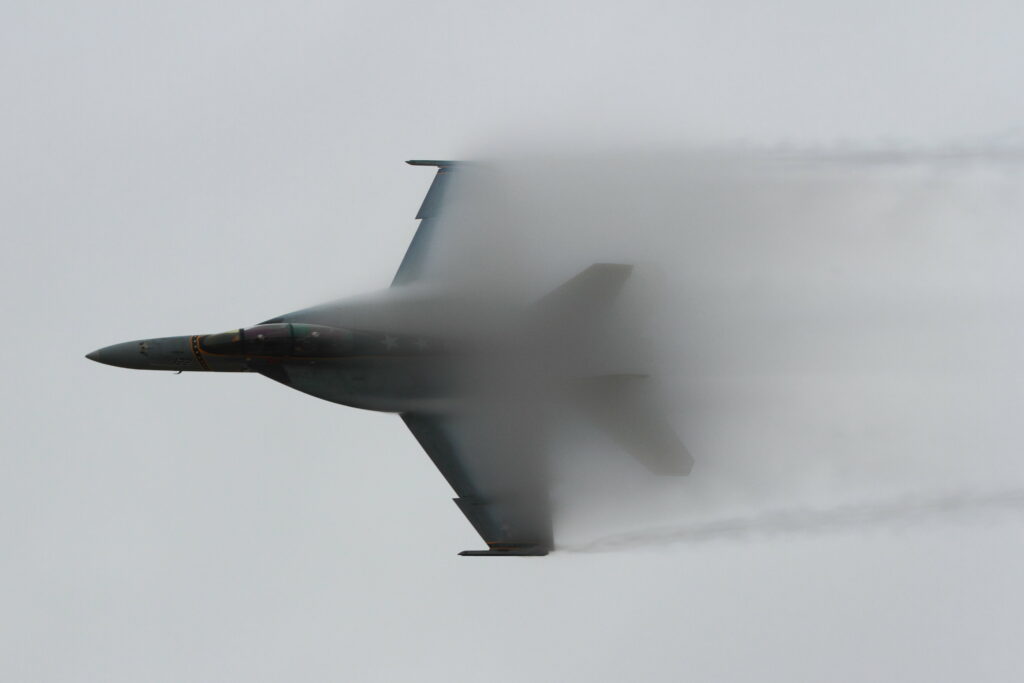
This shot of another high speed pass of the F/A-18 again shows a cloud caused by the aircraft in combination with the moist air.
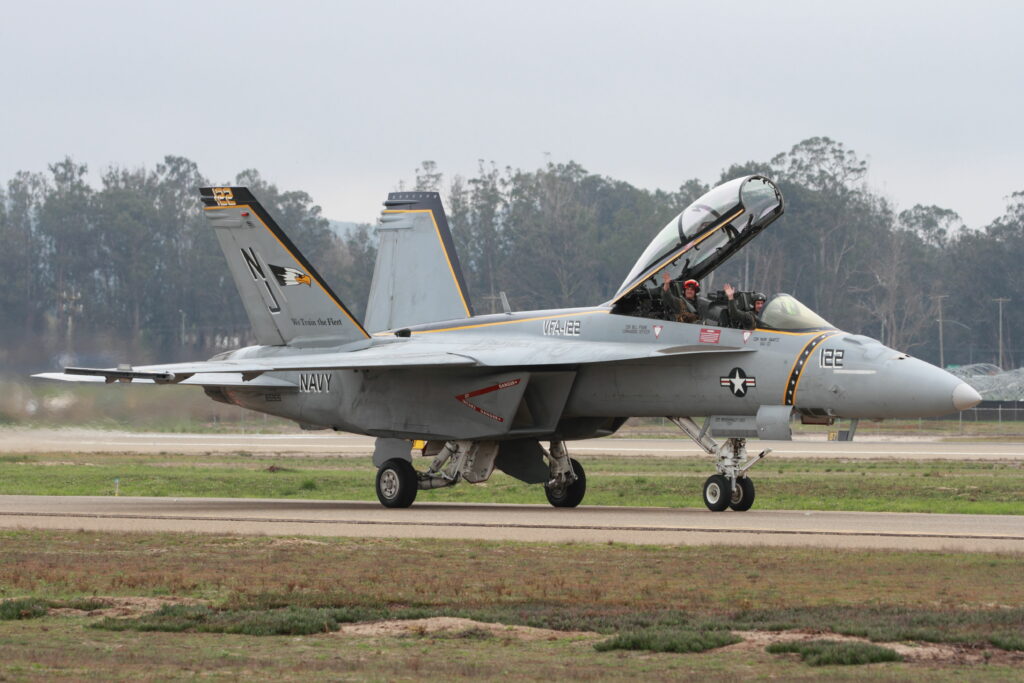
Only after landing the nice colours of this F/A-18 can be admired when it is taxiing back to its parking position. The demo team is part of VFA-122 ‘Flying Eagles’. As can be guessed by the ‘we train the fleet’ titles on the tail, the main task of this squadron is training F/A-18 pilots and weapon systems officers (WSO’s or Wizzos). With the squadron they learn the basics of air-to-air and air-to-ground missions before going to an operational squadron. For this the unit, that is based at NAS Lemoore, has some 60 F/A-18s, of which this colourful one is the one of the commanding officer.
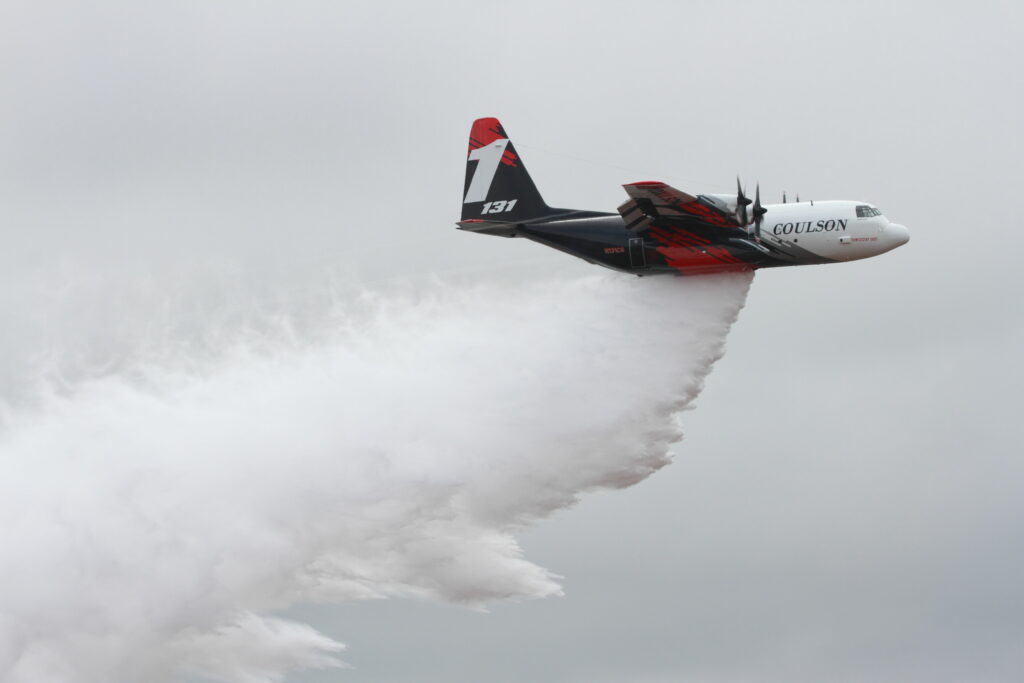
Where firefighting itself is already one of the more exciting and also dangerous jobs in the world, doing it from the air adds another dimension to it. Coulson Aviation is one of the civilian companies that does aerial firefighting and for this they use both helicopters and fixed wing aircraft. The rotary wing consists of S-61, UH-60 and CH-47 helicopters, where the fixed wing component has some Boeing B.737 aircraft plus the C-130 Hercules. One of these famous workhorses is depicted here while spraying its 4,000 US gallons load, that normally consists of fire retardant fluid but in this case for the show is regular water.
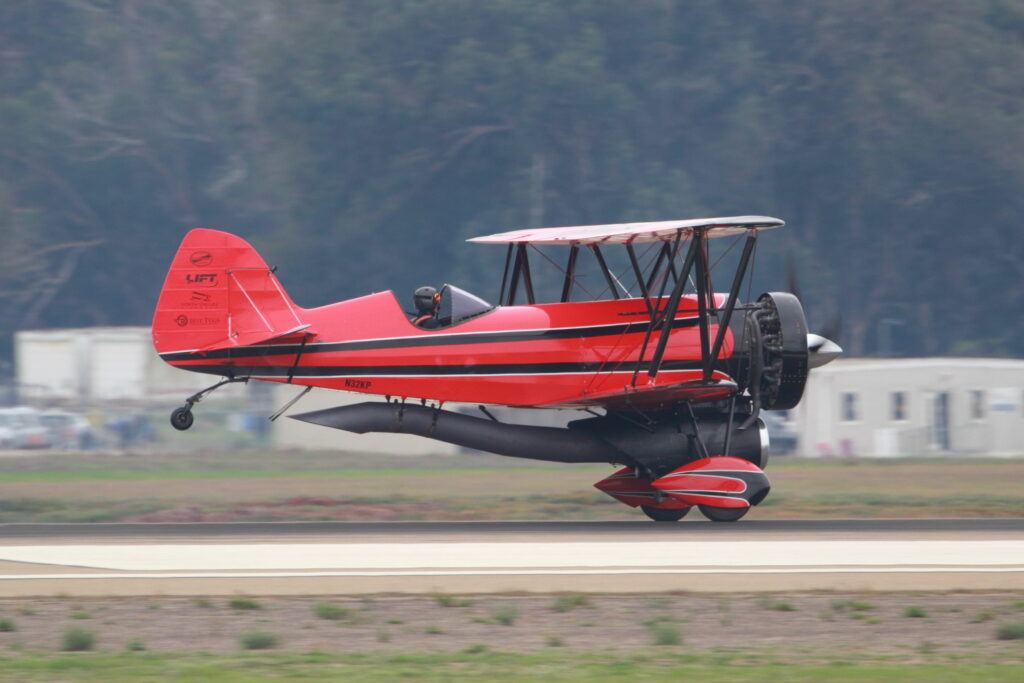
A literally unique aircraft is this Jet Waco Taperwing. A first glance you see an old-fashioned regular biplane, but after a closer look the jet engine under the belly of the aircraft attracts the attention. The jet engine on this one-off aircraft is a General Electric Learjet engine that has been modified to fit under the regular Pratt & Whitney radial engine and gives the aircraft some extra 3,000 pounds of thrust and therefor also a lot of extra speed. And you better believe seeing a propeller drive biplane passing by with 250 mph and also hearing a jet engine at the same time really boggles your mind!
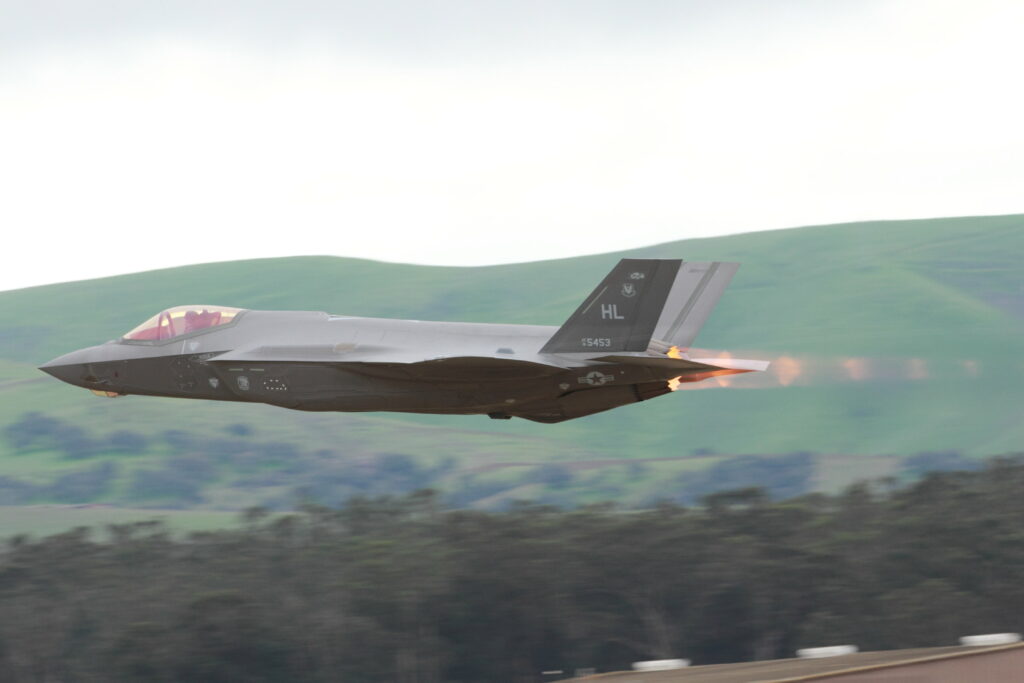
Major Kristin “Beo” Wolfe of the US Air Force F-35A Lightning II Demonstration Team is seen here taking off with full afterburner. In the flame coming out of the exhaust so-called shock diamonds or Mach diamonds are visible, that are the result of a complex process related to density, pressure and velocity. To really understand this you have to be a physicist, but even without understanding it the sight is awesome.
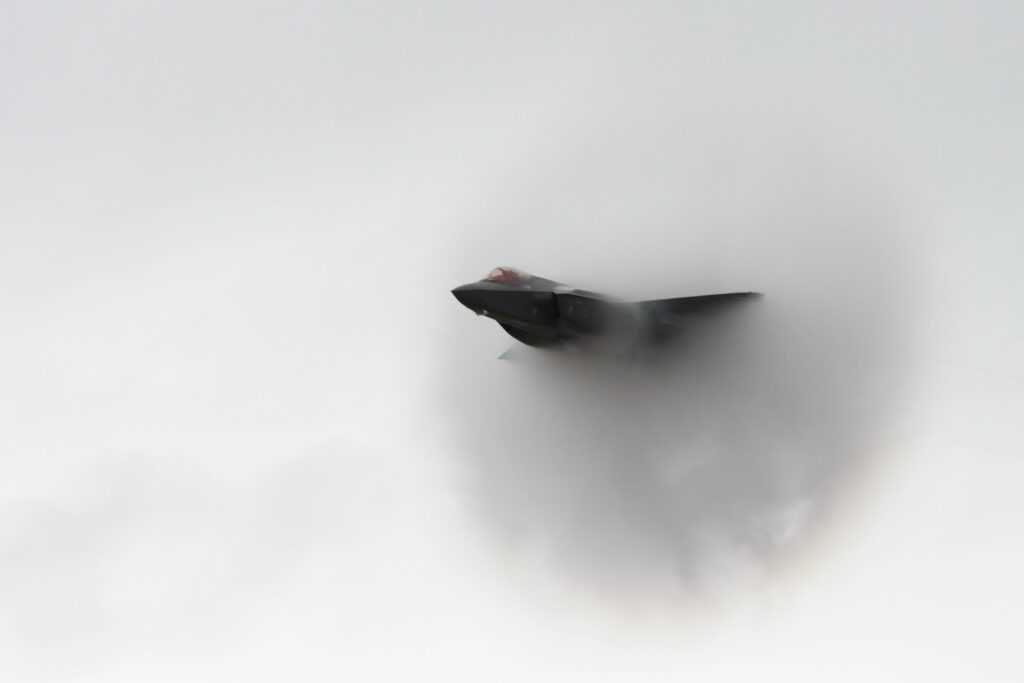
When performing a high speed pass, the F-35 is traveling just below the speed of sound, at .95 Mach, which is approximately 650 knots, or 750 miles per hour. Just like during the display of the F/A-18, the circumstances were ideal for forming a vapour cone.
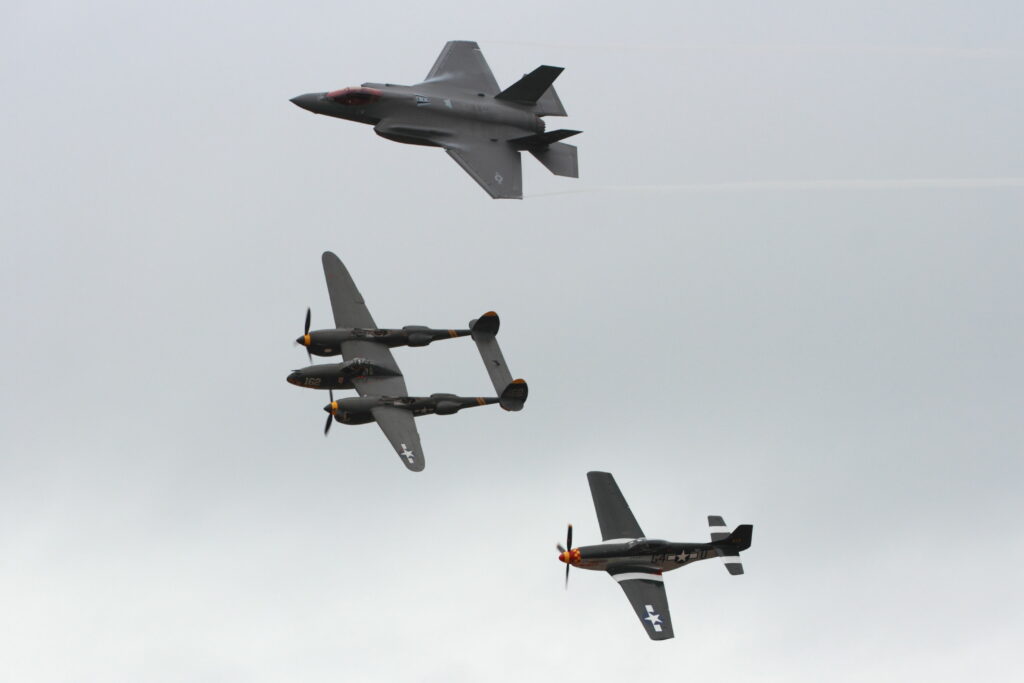
This year 25 years ago the Air Force Heritage Flight was founded. This flight features modern fighter aircraft flying alongside World War II, Korea and Vietnam-era planes. The mixed formations intend to serve as living memorials to the men and women who have served or are currently serving in the US Air Force. Spread out over the country some 10 civilian pilots are qualified to fly vintage warbirds like this P-38 and P-51 in formation with modern Air Force single-ship demonstration teams. Where the P-38 and P-51 had to fly as fast as they could, the F-35 really had to hold back to avoid overtaking the warbirds.
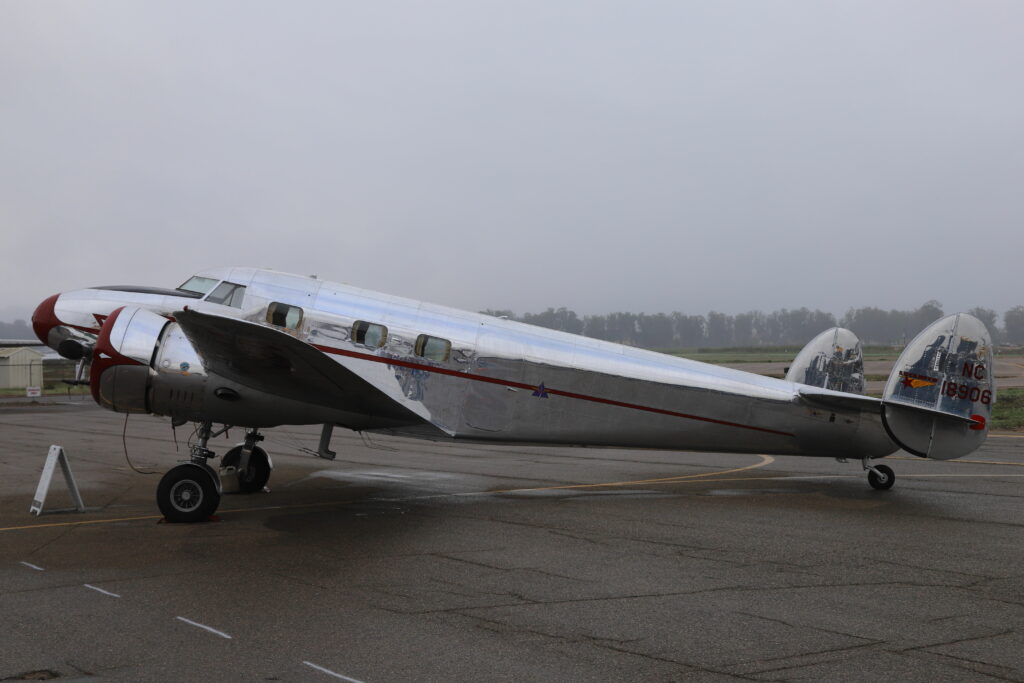
This very shiny Lockheed 12A looks rather modest, compared to all the warbirds on show, but it has a rather interesting history itself as well. It was built in 1940 for the Nevada Development Company but was enlisted as UC-40D with the US Army Air Corps in 1942. It was then quickly sent to the United Kingdom under the Lend-Lease Act and is rumoured to have flown sir Winston Churchill himself during this period. After the war the aircraft became civilian owned again, first in the UK and later on in the United States, France and United States again. And although it changed ownership many times it kept on flying since, even winning multiple awards at different air shows.
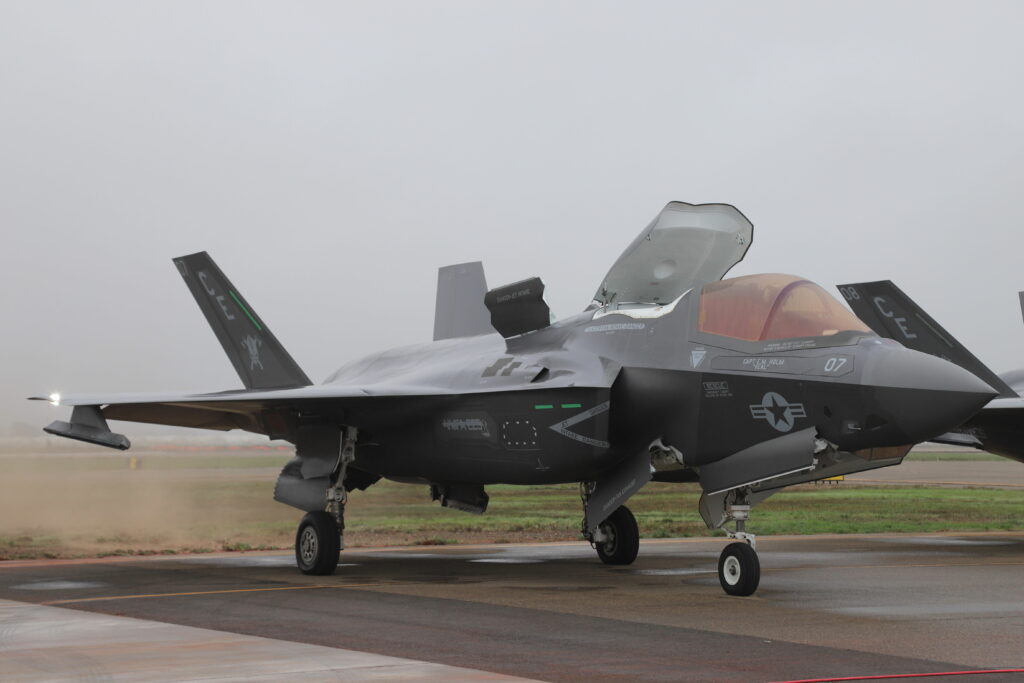
All three versions of the Lockheed-Martin F-35 Lightning II were present at the Central Coast AirFest. Where the F-35A is the conventional take-off and landing (CTOL) version for the US Air Force, the F-35B is the short take-off and vertical landing (STOVL) variant used by the US Marine Corps. Here one of them is testing the vertical landing configuration (exhaust pointing down, doors on spine and belly open) while preparing for a flight.
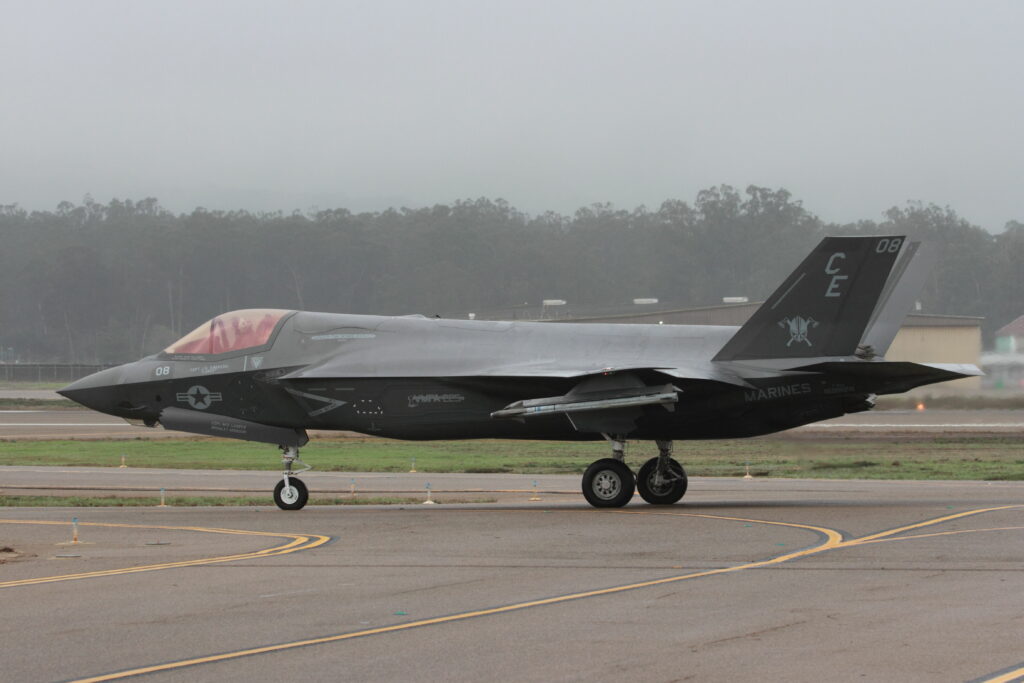
Unfortunately on Saturday only the USAF F-35A flew a demonstration. However those of the audience that arrived early could witness both F-35B departing for a local mission. These are operated by Marine Fighter Attack Squadron 225 (VMFA-225) ‘Vikings’, based at MCAS Yuma, AZ. As stealth is one of the major properties of the F-35, the shape of the aircraft is designed to minimise the radar cross section, and also special radar absorbing paint is used.
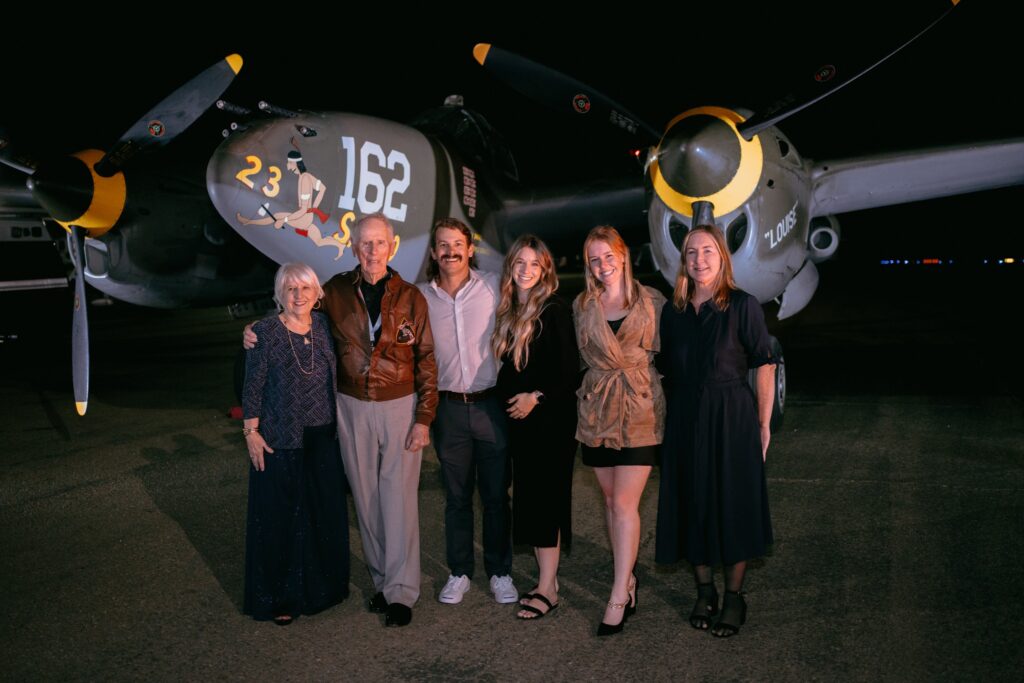
Jim Kunkle sr., the grandfather of air show organisers Heather and Chris Kunkle, flew P-38 Lightnings during World War II. He shot down multiple German fighters over Europe and got shot down himself as well, earning him the Distinguished Service Cross. He turned 100 this year, and as that was celebrated during the show weekend, it was a fitting tribute to have no less than two flying P-38s at Santa Maria. Here he is posing with the whole Kunkle family in front of one of his beloved P-38s. During World War II Santa Maria Army Air Field was home to a training unit for P-38 pilots, and throughout the war Jim flew regularly into Santa Maria Army Air Field as well. (photo via Heather Kunkle)
A big thanks to Heather Kunkle for the hospitality and opportunities during the show!
